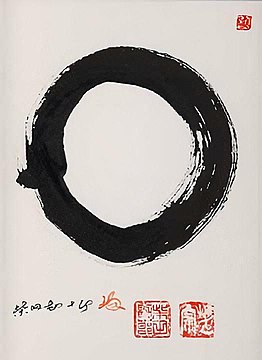
Calligraphy by Kanjuro Shibata XX
Enso ca. 2000
Ensō (円相) is a Japanese word meaning "circle" and a concept strongly associated with Zen. Ensō is one of the most common subjects of Japanese calligraphy even though it is a symbol and not a character. It symbolizes enlightenment, strength, elegance, the Universe, and the void; it can also symbolize the Japanese aesthetic itself. As an "expression of the moment" it is often considered a form of minimalist expressionist art.
In Zen Buddhist painting, ensō symbolizes a moment when the mind is free to simply let the body/spirit create. The brushed ink of the circle is usually done on silk or rice paper in one movement (but the great Bankei used two strokes sometimes) and there is no possibility of modification: it shows the expressive movement of the spirit at that time. Zen Buddhists "believe that the character of the artist is fully exposed in how she or he draws an ensō. Only a person who is mentally and spiritually complete can draw a true ensō. Some artists will practice drawing an ensō daily, as a kind of spiritual exercise."[1]
Some artists paint ensō with an opening in the circle, while others complete the circle. For the former, the opening may express various ideas, for example that the ensō is not separate, but is part of something greater, or that imperfection is an essential and inherent aspect of existence (see also the idea of broken symmetry). The principle of controlling the balance of composition through asymmetry and irregularity is an important aspect of the Japanese aesthetic: Fukinsei (不均斉), the denial of perfection.
The ensō is also a sacred symbol in the Zen school of Buddhism, and is often used by Zen masters as a form of signature in their religious artwork. For more on the philosophy behind this see Hitsuzendo, the Way of the Brush or Zen Calligraphy.
In popular culture[]
The ensō has also been co-opted as an advertising symbol by various companies, notably, Lucent. No longer used since the Alcatel merger, the logo was often jokingly referred to as the "coffee cup ring".[2]
See also[]
- Japanese aesthetics
Notes[]
- ↑ Seo, 2009
- ↑ "The Lucent Logo Legacy: Long Live the Big Red Donut". American Institute of Graphic Arts. 2006. http://www.aiga.org/content.cfm/the-lucent-logo-legacy-long-live-the-big-red-donut. Retrieved 20 September 2009.
References[]
- Seo, Audrey Yoshiko; Addiss (1998). The Art of Twentieth-Century Zen. Stepen. Boston: Shambhala Publications. ISBN 978-1570623585.
- Seo, Audrey Yoshiko; Loori, John Daido (2009). Ensō: Zen Circles of Enlightenment. Weatherhill. ISBN 1-59030-608-2.
- "The Lucent Logo Legacy: Long Live the Big Red Donut". American Institute of Graphic Arts. 2006. http://www.aiga.org/content.cfm/the-lucent-logo-legacy-long-live-the-big-red-donut. Retrieved 20 September 2009.
ca:Enso ja:円相 pt:Ensō ru:Энсо (буддизм) zh:圓相